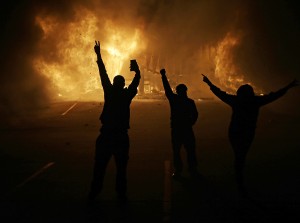Department of Justice Reports on Ferguson
March 5, 2015
Yesterday, a United States Department of Justice (DOJ) inquiry cleared Darren Wilson, a white police officer, of violating the civil rights of Michael Brown. Brown was an unarmed African American teenager whom Wilson shot during a confrontation in Ferguson, Missouri, in August 2014. The department found that witnesses’ claims that Brown had been surrendering when he was shot were not believable. “There is no evidence upon which prosecutors can rely to disprove Wilson’s stated subjective belief that he feared for his safety,” the Justice Department report stated.
On March 3, a separate Justice Department investigation found that Ferguson police had regularly violated the constitutional rights of African Americans. The report noted that blacks had been ticketed and arrested in far greater proportion than their share of the city’s population. The report also identified three city workers as having sent racist e-mails. Ferguson Mayor James Knowles said one of the three employees had been fired and that the other two were under investigation. Knowles outlined a number of reforms the city had implemented to address some of the Justice Department’s concerns. “We must do better not only as a city but as a state and a country. We must all work to address issues of racial disparity in all aspects of our society,” Knowles said.
According to the Justice Department report, one aspect of policing problems in Ferguson centered around using tickets and arrests as a means of funding the city’s budget. The police department and city hall of Ferguson became focused on maximizing the number of tickets, arrests, and citations written by the police in order to fill budgetary gaps caused by low tax revenue. Officers in Ferguson were arresting far more blacks than whites, so black citizens of Ferguson came to feel more and more resentful of this misuse of authority. Meanwhile, Ferguson police saw African Americans not as citizens to be protected, but as “sources of revenue,” according to the DOJ.

People watched as stores burned in November 2014 in Ferguson, Missouri. Protests erupted when a grand jury decided not to indict Ferguson police officer Darren Wilson in the death of Michael Brown, the unarmed, black 18-year-old whose fatal shooting had sparked earlier protests. (AP Photo/David Goldman)
Attorney General Eric Holder stated that a “highly toxic environment” existed between Ferguson police officers and the city’s African American residents before Wilson shot and killed Brown in 2014. “It’s not difficult to imagine how a single tragic incident set off the city of Ferguson like a powder keg,” Holder said. In August 2014, people in Ferguson protested both the shooting and what many believed was a history of unfair treatment of blacks by white authorities. The protests at times involved damage to property, and national media broadcast images of protesters pitted against police clad in riot gear. In November, protests flared anew after prosecutors announced the St. Louis County grand jury’s decision not to indict (bring criminal charges against) Wilson. Some protesters threw objects at police and set a number of buildings and vehicles on fire.
Other World Book articles:


